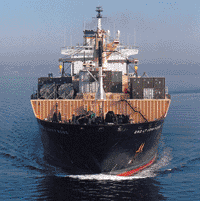Embedded in war: Contractors give crucial support to military

<FONT SIZE=2>U.S. military ships riding at anchor in the Persian Gulf are loaded with the equipment, fuel and supplies needed by the Marine Corps to fight in Iraq. But the people carrying out the day-to-day operations on the Marines' prepositioning ships are not sailors or Marines, but employees of Honeywell International Inc.</FONT>

MV 2nd LT John P. Bobo is one of Military Sealift Command's 33 ships in the prepositioning program.
Military Sealift Command

Contractor support for the military doesn't always occur overseas. SRA International Inc. maintains the National Guard network, which includes 50,000 users across the nation, said Ernst Volgenau, the company's president and chief executive officer.
Olivier Douliery
U.S. military ships riding at anchor in the Persian Gulf are loaded with the equipment, fuel and supplies needed by the Marine Corps to fight in Iraq. But the people carrying out the day-to-day operations on the Marines' prepositioning ships are not sailors or Marines, but employees of Honeywell International Inc.
Their tasks include everything from running forklifts to stocking shelves to handing out ammunition to Marines, all done through a logistics system called AIMS, or the Alliance Information Management System. It allows "end-to-end visibility" of all the stocks in the ship's stores.
This system, which replaced more than 130 legacy information systems, offers automated tracking and refitting of the prepositioning ships. Altogether, Honeywell supports 13 ships under a Maritime Prepositioning Force contract for the Marine Corps, a 10-year, $500 million deal awarded in 1999.
"Our job is to stock, store, issue and repair the equipment," said John Phillips, vice president of government services for Honeywell, Morristown, N.J. "We offload as well. As we speak, we have already done some of this."
Honeywell's work not only illustrates the critical role government IT contractors play in U.S. military readiness, but also shows how the private sector has become more firmly embedded in the fabric of military preparedness and operations.
While contractors have long provided support functions to the military, industry executives said their companies have become more involved in operations and planning, even since the first Gulf War a decade ago.
"The role of contractors has increased dramatically as the role of information technology has increased," said Harris Miller, president of the Information Technology Association of America in Arlington, Va. "Seventy percent to 80 percent of the weapons have some sort of smart weapon capabilities, as opposed to just 30 percent of weapons in the first Gulf War."
Dendy Young, chairman and chief executive officer of GTSI Corp., Chantilly, Va., saw this shift when the company integrated more than 28 products to create a "deployable office" for the Navy's mobile fleet hospital. Five years, ago, he said, the Navy would have done the integration job itself.
"The government looked at suppliers as just that, suppliers of stuff," he said. "Now they are drawing us in as participants. They want to use our intellectual property."
Computer Sciences Corp. of El Segundo, Calif., another prominent IT defense company, has more than 2,100 employees supporting the U.S. government in the area, including personnel from DynCorp, recently purchased by CSC.
"The bulk of these employees provide support in the areas of logistics, aviation maintenance and base operations and support," said company spokesman James Sullivan.
[IMGCAP(2)]
Providing hands-on support to military troops doesn't always mean being shipped out. SRA International Inc. in Fairfax, Va., has provided support to the reserve components of the Army, Navy and Air Force for many years, said Ernst Volgenau, president and CEO.
SRA manages and maintains the National Guard's network, which includes 50,000 users across 3,400 cities. Work supporting that network has accelerated as many units have been called to active duty, he said.
While the role of contractors has expanded, actual "combat service support is increasingly done by the reserve units," Volgenau said. "The military generally doesn't put contractors in direct combat support, though that can happen." During World War II, civilian scientists flew on bombing runs over Europe to look for ways to improve operations, "but that's the exception rather than the rule," he said.
SRA does have employees in the Gulf region, but Volgenau declined to say how many.
Aerospace companies always have been deeply involved in war efforts because of their role in supplying planes and munitions, "but our role has changed significantly," said John "Jack" London, chairman and CEO of CACI International Inc. in Arlington, Va.
During the 1991 Gulf War, CACI was primarily involved in logistics support and modeling and simulation, but as the military has increased its reliance on communications systems and networks, CACI's role has changed, he said. The military also is outsourcing more of the operations and maintenance of these systems, he said.
In the past year, CACI has seen revenue grow 20 percent and will hit about $830 million in 2003. Much of that growth is attributable to the military buildup, London said. About 66 percent of CACI revenue is defense and intelligence related.
London declined to say how many CACI employees are working in the Persian Gulf region, but said the number is "significant." The company has been involved in setting up communications centers and network operations centers as well as working on surveillance and sensor systems for intelligence operations, he said.
Top defense contractor Lockheed Martin Corp. has sent IT technicians and support staff to the region to provide real-time support of the military's systems integration programs, a company official said.
Lockheed also designed aircraft and satellite imagery systems, which are being used to provide real-time information to Defense Department officials on everything from battle damage to humanitarian aid delivery, the official said.
About 80 percent of Anteon International Corp.'s $826 million in 2002 revenue is attributable to contracts with the defense and intelligence communities, said Mark Heilman, executive vice president of business development for the Fairfax, Va., company.
One way Anteon is supporting the troops is the setup of a new Military Operations on Urban Terrain site in Kuwait. The MOUTs are urban training facilities to prepare troops for fighting in the streets and buildings of a city such as Baghdad.
The company received a $6.8 million contract in February to produce two mobile MOUT facilities to send to Kuwait and Afghanistan.
The first unit was shipped to Kuwait March 7, offloaded there March 9, and fully operational by March 12. The first live-fire training exercise took place March 15, the company said in a press release.
Right now Anteon has 200 people stationed internationally, and another 90 to 100 people traveling in support of customers, said Pat Dawson, senior vice president of administration, plus another 40 reservists who have been called to duty.
Dawson, himself a reservist who served during Operation Desert Storm in 1991, said that the active military has decreased in size by as much as 35 percent to 38 percent, and the reserves have shrunk similarly.
As a result, "there are more contractors in the area of the battlefield than 12 years ago. That's a big change," he said.
Dawson said the shrinking of the military requires that infrastructure services be farmed out to contractors, or else too many warfighters have to be diverted into support functions.
ITAA's Miller said he did not know how many contractors were in the Persian Gulf region, but that the number is more than 10,000. "I know one company almost has that many alone," he said.
Such proximity to the fighting can put contractors at risk. In January, one American was killed and another wounded in a shooting in Kuwait. Both were employees of Tapestry Solutions Inc., San Diego, a technology contractor supporting the Army there.
Two of the 13 vessels supported by Honeywell are hospital ships to handle casualties. Phillips wouldn't say specifically where any of the ships were deployed or how many Honeywell employees were based on them, but he said the ships are intended to support Marines going into harm's way.
As for the employees, Phillips said they volunteered for the assignment. "It is not a condition of employment," he said. *
Staff Writer Patience Wait can be reached at pwait@postnewsweektech.com. Senior Editor Nick Wakeman and Staff Writer Joab Jackson contributed to this story.

